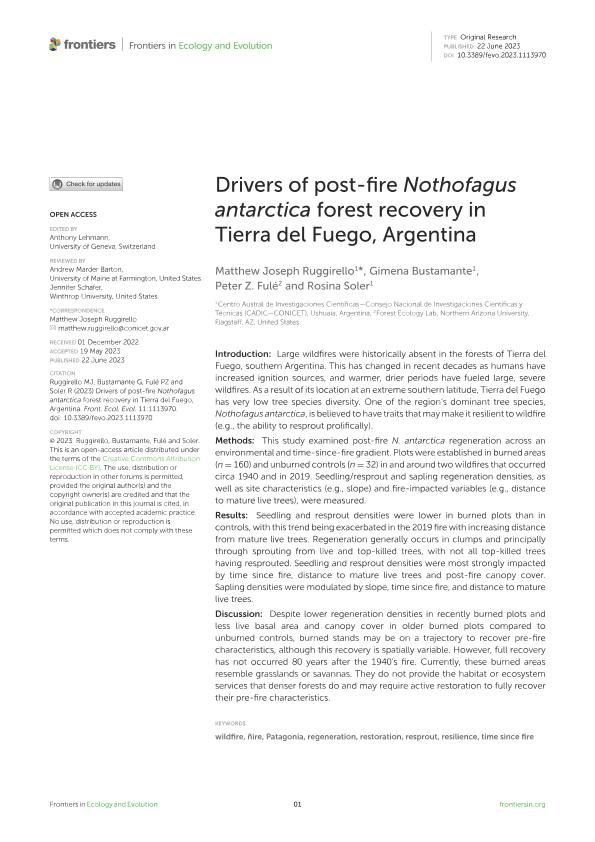Artículo
Drivers of post-fire Nothofagus antarctica forest recovery in Tierra del Fuego, Argentina
Fecha de publicación:
06/2023
Editorial:
Frontiers Media
Revista:
Frontiers in Ecology and Evolution
ISSN:
2296-701X
Idioma:
Inglés
Tipo de recurso:
Artículo publicado
Clasificación temática:
Resumen
Introduction: Large wildfires were historically absent in the forests of Tierra del Fuego, southern Argentina. This has changed in recent decades as humans have increased ignition sources, and warmer, drier periods have fueled large, severe wildfires. As a result of its location at an extreme southern latitude, Tierra del Fuego has very low tree species diversity. One of the region's dominant tree species, Nothofagus antarctica, is believed to have traits that may make it resilient to wildfire (e.g., the ability to resprout prolifically). Methods: This study examined post-fire N. antarctica regeneration across an environmental and time-since-fire gradient. Plots were established in burned areas (n = 160) and unburned controls (n = 32) in and around two wildfires that occurred circa 1940 and in 2019. Seedling/resprout and sapling regeneration densities, as well as site characteristics (e.g., slope) and fire-impacted variables (e.g., distance to mature live trees), were measured. Results: Seedling and resprout densities were lower in burned plots than in controls, with this trend being exacerbated in the 2019 fire with increasing distance from mature live trees. Regeneration generally occurs in clumps and principally through sprouting from live and top-killed trees, with not all top-killed trees having resprouted. Seedling and resprout densities were most strongly impacted by time since fire, distance to mature live trees and post-fire canopy cover. Sapling densities were modulated by slope, time since fire, and distance to mature live trees. Discussion: Despite lower regeneration densities in recently burned plots and less live basal area and canopy cover in older burned plots compared to unburned controls, burned stands may be on a trajectory to recover pre-fire characteristics, although this recovery is spatially variable. However, full recovery has not occurred 80 years after the 1940's fire. Currently, these burned areas resemble grasslands or savannas. They do not provide the habitat or ecosystem services that denser forests do and may require active restoration to fully recover their pre-fire characteristics.
Palabras clave:
PATAGONIA
,
REGENERATION
,
RESILIENCE
,
RESPROUT
,
RESTORATION
,
TIME SINCE FIRE
,
WILDFIRE
,
ÑIRE
Archivos asociados
Licencia
Identificadores
Colecciones
Articulos(CADIC)
Articulos de CENTRO AUSTRAL DE INVESTIGACIONES CIENTIFICAS
Articulos de CENTRO AUSTRAL DE INVESTIGACIONES CIENTIFICAS
Citación
Ruggirello, Matthew; Bustamante, Gimena Noemi; Fulé, Peter Z.; Soler Esteban, Rosina Matilde; Drivers of post-fire Nothofagus antarctica forest recovery in Tierra del Fuego, Argentina; Frontiers Media; Frontiers in Ecology and Evolution; 11; 6-2023; 1-12
Compartir
Altmétricas




